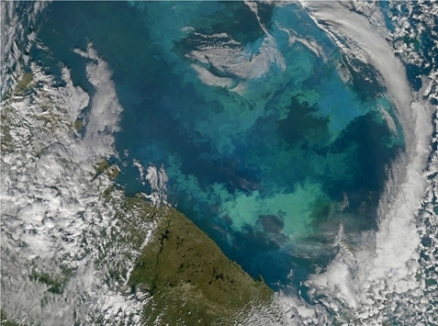Barents Sea
Seas of the World 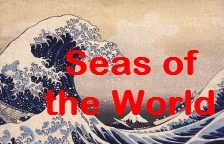 The Barents Sea is one of the Arctic seas found on the Siberian shelf; part of the larger Arctic mediterranean Sea (are mostly enclosed by land).
The Barents Sea is one of the Arctic seas found on the Siberian shelf; part of the larger Arctic mediterranean Sea (are mostly enclosed by land).
It is located north of the mainlands of Norway and Russia (and the White Sea), and south of the Arctic Ocean proper to the north. The eastern limit is the Russian island of Novaya Zemlya and the Kara Sea. To the west the transition the Greenland Sea and the more southerly Norwegian Sea is marked by a line from the island of Spitzbergen, in the Norwegian archipelago of Svalbard, soth to Bear Island and on the North Cape, Norway.
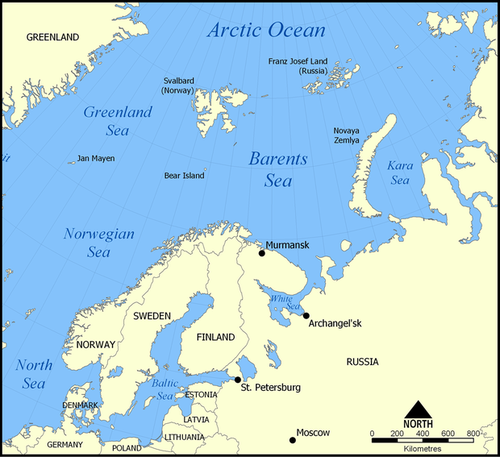 Regional setting of the Barents Sea. Source: Norman Einstein
Regional setting of the Barents Sea. Source: Norman Einstein
The sea is named after Willen Barentsz, a Dutch cartographer and explorer, who particpated in three expeditions Arctic seas from 1594 to 1597; dying on the last expedition.
The location of the border between Norway and Russia in the Barents sea has long been disputed. This has been of increased significant in recent years with exploration for oil and natural gas in the region. In April 2010, the two sides announced an agreement to resolve the boundary issue.
During the winter, the northern part of the Barents sea is covered with sea ice. It is mostly ice free during the summer.
The Russia port of Murmansk is the largest port on the Barents Sea.
"The Barents Sea is an area of intensive human activity. Historically human activity has related to fishing and hunting of marine mammals. Nowadays human activities also involve transportantion of goods, oil and gas related activity and tourism. The large-scale harvesting in the Barents Sea has strong impact not only on the state of commercial species but also on the ecosystem as a whole. On the other hand, the ecosystem is strongly influenced by climatic conditions. Year-to-year variations in the strength of inflow of Atlantic water lead to adjustments in the ecosystem and, hence, to changes in fish production. In addition to climatic conditions, which govern the formation of primary biological production and feeding conditions for fish as well as the survival of their progeny, an important factor that influences the abundance and dynamics of commercial species is inter-specific trophic relations." (Stiansen and Filin)
The average depth of the Barents Sea is 230 meters. Its maximum depth of about 500 m occurs on its western boundary.
Contents
Water Masses
The Barents Sea includes three principal water masses:
- Warmer, more saline waters from the Atlantic (red in the figure below)
- Colder, less saline waters from the Arctic (blue)
- Warmer, less saline coastal waters (green)
The sea includes the boundary between Atlantic and Arctic waters known as the Polar Front.
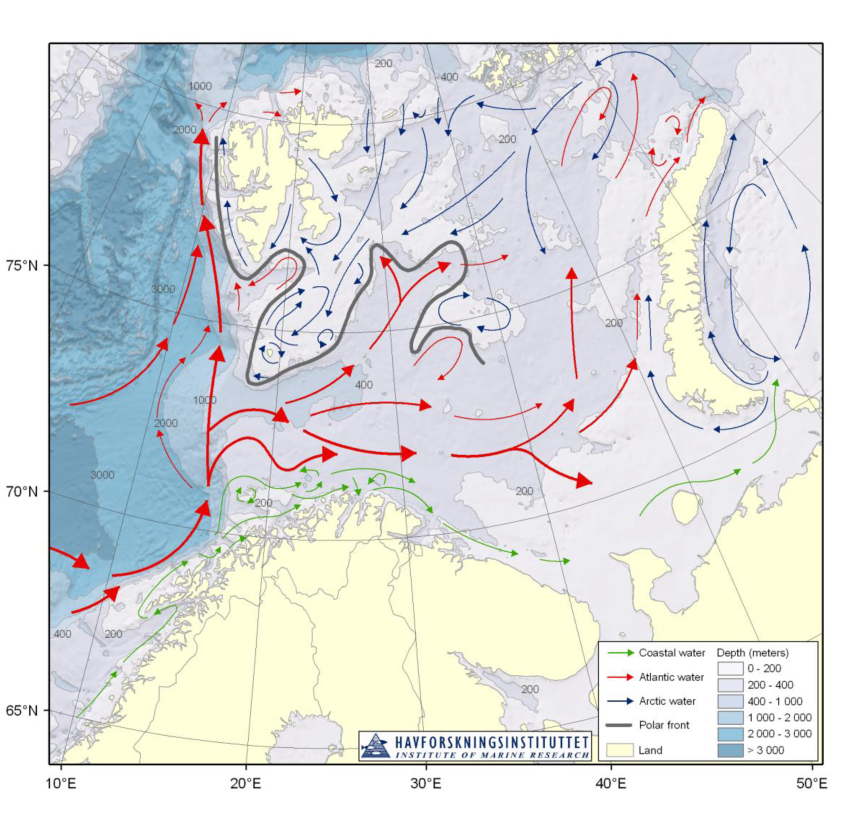 The main features of the circulation and bathymetry of the Barents Sea. Source: PINRO/IMR report.
The main features of the circulation and bathymetry of the Barents Sea. Source: PINRO/IMR report.
Thus, the Barents sea is a key region for the modification of water masses in the Arctic, being one of several marginal seas in the Arctic. In this modification process, water flowing over shallow regions is transformed when heat loss and brine injection during the formation of sea ice increase density in the winter and sea ice meltwater, and river runoff decreases surface water density in the summer.
Barents differs from the other marginal seas in the region in that it has close connections with both the Norwegian Sea and the Arctic Ocean; thus it has a greater effect on thermohaline circulation than most Arctic seas.
To the extent that there has been moderate warming of the southern terrestrial margin of the Barents Sea since at least the 1700s, thawing of permafrost has created expansion of valuable pasture lands for the indigenous peoples relative to amplified reindeer populations.
Marine Ecosystem
See main article: Barents Sea large marine ecosystem
The Barents Sea is classified a Class II, moderately high productivity (150-300 grams of carbon per square meter per year), ecosystem.There are three major current systems, the Norwegian coastal current, the Atlantic current and the Arctic current systems; moreover, bottom topography strongly influences the circulation and distribution of water masses.
Climatic variations over the Barents Sea depend chiefly on the activity and temperature of the inflowing Atlantic water. These climatic conditions, and the extent of the ice cover, have a pronounced effect on bioproductivity and fish stock recruitment. There are significant interannual variations in spring phytoplankton bloom dynamics, zooplankton stocks and fish recruitment. Predation pressure and climatic fluctuations are possible causes for these variations.
The high latitude ecosystem is characterized by a food web with few dominant species (diatom, krill, capelin, cod). However, interactions between fish and zooplankton as well as among fish stocks have led to marked changes in the trophic pathways and in fish and zooplankton abundance.
The capelin biomass has severely declined. Predation by young herring on capelin larvae is regarded as the main cause of the recruitment failure of capelin in the Barents Sea. Thus, periods of high abundance of young herring (1983, and 1991-1992) were followed by low capelin abundance. As capelin are the key species of the Barents Sea, the collapse of the stock caused food shortages for higher trophic level populations such as cod, Harp seals, and guillemots. Cod, which preys heavily on capelin, had to switch to macrozooplankton such as krill and amphipods as its main prey when the capelin levels were low.
Much higher in the food chain of the Barents Sea ecosystem are marine mammals including the Polar bear, Ursus maritimus, seven species of pinnipeds (seals and walruses), and 17 species of cetaceans (whales, porpoises and dolphins). Moreover, the Polar bear conducts wide ranging pelagic migrations using both pack ice and swimming to cover vast distances; U.maritimus has one of its five taxonomically recognisable Eurasian sub-populations within the Barents Sea basin. Polar bear denning occurs occurs in summer on the terrestrial margin of the Barents Sea.
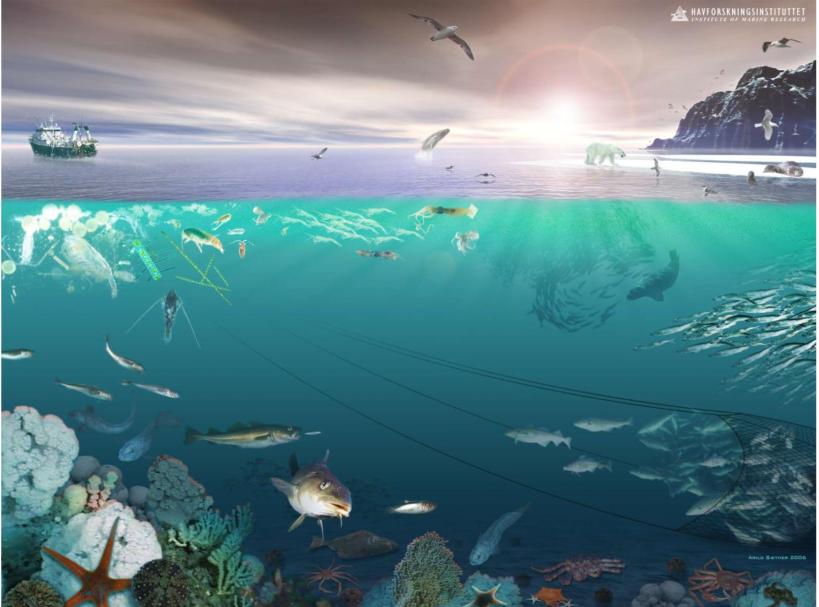 Illustration of the rich marine life and interactions in the Barents Sea. Source: Joint PINRO/IMR report
Illustration of the rich marine life and interactions in the Barents Sea. Source: Joint PINRO/IMR report
Fisheries
See: Fisheries and aquaculture in the Northeast Atlantic (Barents and Norwegian Seas)
The Barents Sea is an important feeding area for cod, capelin, haddock, herring, sea perch, catfish, plaice, halibut, Atlantic salmon and redfish, supporting large fisheries.
There was a catch decline for almost all the commercial fish species in recent times.
Annual cod catches are around 250,000 tons. The herring stock was very low in the 1970s due to overfishing in the 1960s. 1983 saw a strong year class, as did the warm years of 1989-1991. The Barents Sea capelin stock is potentially the largest capelin stock in the world, with its biomass in some years reaching four to eight million metric tons. It was the largest Norwegian (Norway) fishery in terms of total catch. Capelin is a plankton feeder and migrates on a large scale to exploit the plankton productivity of the northern Barents Sea, trailing the retreating ice with a time delay. However, the fish resource has shown major changes in the past several decades. In the late 1970s, the annual fish catch was around 2.5 million metric tons. In 1986, it collapsed to a stock size of less than 100,000 metric tons. At present, the annual catch is around one million metric tons. The significant decline led to a complete closure of the capelin fishery from 1994 to 1998.
More recently the capelin stock has started to increase again. Because the capelin occupies a key role as an intermediate link in the food web, this stock affected other components of the Barents Sea ecosystem, leading to the poor growth of cod, massive seal invasions along the Norwegian coast, and high seabird mortality. Preceding the capelin decrease, strong year classes of cod, haddock, and herring were produced in 1983. There was also an observed transition between cold and warm climatic periods, suggesting that good recruitment is related to increased or altered inflow activity into the Barents Sea.
Climate Change Implications of the Terrestrial Margin
See main article: Climate change impacts on the Yamal Nenets of northwest Siberia
The overall implications of moderate warming for the indigenous Yamal Nanets peoples of the northwest Siberian tundra are generally favourable. Since the eighteenth century there appears to have been a gradual warming trend in the region, providing more available parture land for native reindeer, which are a key subsistence staple for the native Nanets.
The greater problem for the indigenous Yamal Nenets peoples has not been climate change, but has been the collectivisation practises begun in the communist period of the Soviet Union. These practises encouraged settlement by non-native peoples and overgrazing and overfishing of the regional resources.
Further Reading
- Stiansen, J.E and A.A. Filin (editors), Joint PINRO/IMR report on the state of the Barents Sea ecosystem 2006, with expected situation and considerations for management. IMR/PINRO Joint Report Series No. 2/2007. ISSN 1502-8828. 209 pp. Contributing authors in alphabetical order: Aglen, N.A. Anisimova, B. Bogstad, S. Boitsov, P. Budgell, P. Dalpadado, A.V. Dolgov, K.V. Drevetnyak, K. Drinkwater, A.A. Filin, H. Gjøsæter, A.A. Grekov, D. Howell, Å. Høines, R. Ingvaldsen, V.A. Ivshin, E. Johannesen, L.L. Jørgensen, A.L. Karsakov, J. Klungsøyr, T. Knutsen, P.A. Liubin, L.J. Naustvoll, K. Nedreaas, I.E. Manushin, M. Mauritzen, S. Mehl, N.V. Muchina, M.A. Novikov, E. Olsen, E.L. Orlova, G. Ottersen, V.K. Ozhigin, A.P. Pedchenko, N.F. Plotitsina, M. Skogen, O.V. Smirnov, K.M. Sokolov, E.K. Stenevik, J.E. Stiansen, J. Sundet, O.V. Titov, S. Tjelmeland, V.B. Zabavnikov, S.V. Ziryanov, N. Øien, B. Ådlandsvik, S. Aanes, A. Yu. Zhilin.
- Institute of Marine Research, Bergen, Norway
- L.Midttun. 1985. Formation of dense bottom water in the Barents Sea. Deep Sea. Res. 32:1233-1241.
- Peter Saundry. 2011. Seas of the world. Topic ed. C.Michael Hogan. Ed.-in-chief Cutler J.Cleveland. Encyclopedia of Earth.
- L. Zenkevitch. Biology of the Seas of the U.S.S.R. Wiley Interscience, 1963.
- S. L. Pfirman, D. Bauch, and T. Gammelsrod. The Northern Barents Sea: Water mass distribution and modification. In O. M. Johannessen, R. D. Muench, and J. E. Overland, editors, The Polar Oceans and Their Role in Shaping the Global Environment, pages 77–94.?, 1994.
- S. L. Pfirman, J. K¨ogeler, and B. Anselme. Coastal environments of the western Kara and eastern Barents Sea. DSR II, 42:1391–1412, 1995
- C. Michael Hogan. 2008. Polar Bear: Ursus maritimus, Globaltwitcher.com, ed. N. Stromberg.
- Harris et al. 1998.
